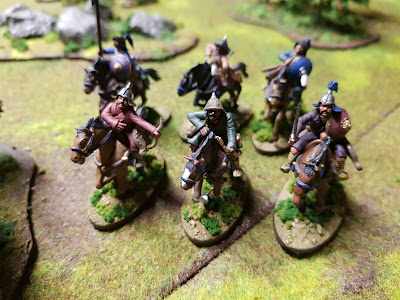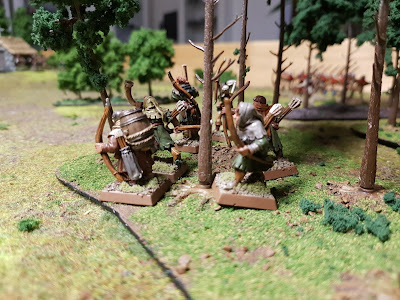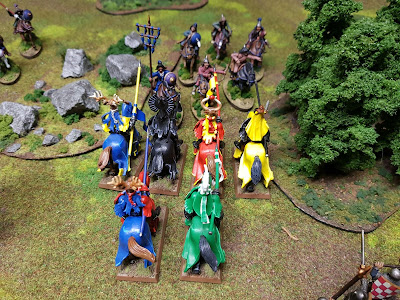Ich lieeeeeebbbeeeee es alte Figuren, die schon lange Zeit traurig in den Schubladen meines Arbeitszimmers ihr Dasein führen, letztendlich auf den Spieltisch zu bringen.
Im Fall meiner Bretonen ist das eine ganz besondere Geschichte.
Ich gehöre ja zu der Kategorie der Figurensammler, die sehr spät zum Wargaming Hobby gekommen sind.
Die Bretonen hatte ich mir irgendwann in den 0er Jahren zusammengekauft und auch schon länger bemalt.
Mir ging es beim damaligen Kauf nur um die Modelle, denn die hatten mir schon seit geraumer Zeit gefallen. Gespielt habe ich mit denen tatsächlich nie.
Jetzt hat Sven seine Mongolen für ein historisches Setting bemalt, und nach einem kurzen Ideenaustausch kam uns die Idee, komm… lass uns Bretonen in die Schlacht gegen Kislev führen.
Warhammer Fantasy Fans kennen diese beiden Reiche der „Alten Welt“.
Und es passt einfach zuuuuu gut.
Eines der Völker des kislevitischen Reiches sind die Ungolen. Dass bei diesen wilden Kämpfern die mongolischen Reiterheere Vorbild waren, ist auf den ersten Blick erkennbar, und so war der Gedanke schnell gefasst, und auch schnell umgesetzt.
Einmal die Bretonen abstauben, in eine 24 Punkte Einheit für Lion/Dragons Rampant zusammenfassen, und auf geht’s.
Wir spielten bei diesem Testspiel eine reine Begegnungsschlacht frisch nach dem Motto meiner Adler Mannheim „Druff unn e wedder“; für Norddeutsche übersetzt, heißt das also ein reines Hau Drauf Spiel.
Meine Einheit bestand aus einer Einheit Ritter des Königs, zwei Abteilungen Fußknechte, 2 Abteilungen Bogenschützen und einer Bidower (leichte Truppe, Waldläufer) Einheit, angeführt von dem Robin Hood der Warhammer Welt, der in dieser Welt Bertrand le Brigand heißt.
(an dieser Stelle in meinem BLOG hatte ich schon mal über die Bogenschützen von Bergerac geschrieben:
Geschichte als Hobby: Sehen - Lesen - Spielen: Bergerac (thrifles.blogspot.com)
)
Sven hatte 3 Reitereinheiten am Start. 2 x leichte Reiter mit Bögen bewaffnet, die die Spezialeigenschaften Skirmish und Evade hatten.
Heißt. Sie können mit einer halben Bewegung vorreiten und
schießen (skirmish), bzw. auch einem Angriff ausweichen (evade).
Serjeanten mit dem General als Anführer ergänzten die Reiterei.
Hinzu kam noch eine ebenfalls mit Fernwaffen ausgerüstete Fußkämpfereinheit, sowie eine Bidower Einheit.
Hinzu kam noch eine ebenfalls mit Fernwaffen ausgerüstete Fußkämpfereinheit, sowie eine Bidower Einheit.
Eine Einheit weniger als ich???
Ja. Dafür hatte Sven ein paar Elitekämpfer am Start.
Das Spiel begann damit, dass wir uns erst einmal aufeinander zubewegen mussten.
Also alle Einheiten nach vorne.
Sven reagierte ähnlich.
Meine Flagellantentruppe – reiner Sidekick, also Zivilisten ohne Funktion – wanderten zum kleinen Kloster auf dem Berg, und es war Ihnen egal, dass da schon die kislevitischen Bidower standen.
Gesänge helfen gegen Pfeile.
Ich formierte meine Einheiten in einer Angriffslinie.
Die Ritter hielt ich noch etwas zurück, weil ich sie nicht direkt in einem „Wild Charge“ losstürmen lassen wollte. Das passiert unweigerlich, wenn sie sich einer gegnerischen Einheit auf 10“ nähern.
Svens Reiter lauerten auf meinen Fehler.
Dann zog ich meine Bogenschützen am linken Flügel hinter eine Deckung.
Meine Bidower schauten vorsichtig aus dem Waldstück; aber hier am rechten Flügel passierte noch nichts.
In der Mitte beorderte ich die vordere Einheit meiner Fußknechte in den Schildwall. Das sollte ihnen im Fall eines Nahkampfes einen besseren Verteidigungswert geben.
An deren linker Seite fächerten meine Ritter aus.
Erste Verluste hatten meine Fußknechte, weil sie unter Beschuss gerieten.
Das konnte ich jetzt nicht auf mir sitzen lassen und meine Ritter stürzten sich mit dem lauten Kriegsschrei „Bretonnnniiiiiiaaaaaaa“ auf den Feind.
Die Ungolen konnten zurückgeworfen werden.
Aber schon im nächsten Zug erhielten die Ritter Flankenfeuer der zweiten ungolischen Reitereinheit.
Der erste Ritter fiel.
Dann schoss nochmals die andere Einheit.
Ein weiterer Treffer und Verlust.
Den Vorteil erkennend, warf sich im direkten Anschluss der Ungolenhäuptling mit seiner Reitereinheit in den Nahkampf.
Die Ritter schlugen zurück, mussten sich aber zurückziehen.
Die Ritter schlugen zurück, mussten sich aber zurückziehen.
So sah das Ganze jetzt von oben aus.
Am rechten Flügel zog ich die Bidower nach vorne.
In der Mitte des Schlachtfeldes ging der Kampf weiter.
Auch die ungolischen Reiter hatten die ersten Verluste.
In den nächsten Zügen prügelten sich unsere Einheiten
weiter in der Schlachtfeldmitte. Es ging hin und her.
Letztendlich war es dann aber so, dass nur noch mein Rittergeneral überlebte und ich gezwungen war die Infanterie vor ihn zu bringen, um die Einheit vor dem Totalverlust zu retten.
Letztendlich war es dann aber so, dass nur noch mein Rittergeneral überlebte und ich gezwungen war die Infanterie vor ihn zu bringen, um die Einheit vor dem Totalverlust zu retten.
Es dauerte nicht lange und die Fußknechte standen mit dem Mongolengeneral und seiner Elite im Nahkampf. Der ging final auch für meine Fußknechte in die Hose, und sie sahen sich schlussendlich auf dem Rückzug.
Am rechten Flügel gaben meine Bidower Flankenfeuer auf eine von Svens Reitereinheiten. Zunächst erfolgreich, gerieten die Bidower dann aber selbst unter Gegenfeuer der Reiter und ihrer ungolischen Pendants, die sich an der Kapelle positioniert hatten.
Gleiches Ergebnis, wie bei den Fußknechten. Auch hier der Rückzug.
Es brachte dann nichts mehr, dass meine Bogenschützen am rechten Flügel die Ungolen aus der Kapelle vertreiben,
und die am linken Flügel die ungolische Infanterie auf Abstand hielten.
Die vielen Moraltests, die ich jetzt mit den angeschlagenen Einheiten würfeln musste, entschieden letztendlich das Spiel.
In der letzten Runde platzte eine Einheit nach der anderen, und Sven konnte zur finalen Attacke blasen.
Ein interessantes Spiel, das sehr lange auf der Kippe stand.
Am Ende mussten wir aber feststellen, dass der Verlust der Einheiten doch sehr spielwirksam werden kann. Moraltests werden definitiv schwerer, und das führt dann vor allem bei mehrmaliger Wiederholung, wenn Einheiten „Battered“, also angeschlagen sind, höchstwahrscheinlich auch zum Platzen der Einheit.
Es wird nicht das letzte Mal gewesen sein, dass wir diese Einheiten ins Spiel führten.
More to come.
In the case of my Bretons, this is a very special story.
I belong to the category of figure collectors who came to the wargaming hobby very late.
I bought the Bretons sometime in the early yeras oft he millenium and had been painting them for a while.
When I bought it at the time, I was only interested in the models, because I had liked them for quite some time. I've actually never played with them.
Now Sven has painted his Mongols for a historical setting and after a short exchange of ideas we came up with the idea, come on… let's lead Bretons to the battle against Kislev.
Warhammer Fantasy fans know these two kingdoms of the "Old World".
And it just fits toooooo well.
One of the peoples of the Kislevite Empire are the Ungols. The fact that the Mongolian cavalry armies were the model for these fierce fighters can be seen at first glance, and so the idea was quickly conceived and quickly implemented.
Dust off the Bretons once, combine them into a 24-point unit for Lion/Dragons Rampant, and let's go.
In this test match, we played a pure face-to-face battle.
My unit consisted of a unit of King's Knights, 2 squads of Footmen, 2 squads of Archers and a Bidower (light troop, rangers) squad, led by the Robin Hood of the Warhammer world, known in this world as Bertrand le Brigand.
(at this point in my BLOG I had already written about the archers of Bergerac:
Geschichte als Hobby: Sehen - Lesen - Spielen: Bergerac (thrifles.blogspot.com)
)
Sven had 3 rider units at the start. Two units light horsemen armed with bows that had the Skirmish and Evade special abilities:
You can advance and shoot (skirmish) with half a movement, or dodge an attack (evade).
One unit Serjeants with the general completed the cavalry force.
There was also a foot fighter unit, also equipped with long-distance weapons, and a Bidower unit.
One unit less than me???
Yes. But Sven had a few elite fighters at the start.
The game started with us having to move towards each other first.
So all units forward.
Sven reacted similarly.
My flagellant force - pure sidekick, that is, civilians with no function - wandered off to the little monastery on the hill, and they didn't care that the Kislevite bidowers were already there.
Chants help against arrows.
I formed my units in a line of attack.
I held the knights back a bit because I didn't want them to charge straight away in a wild charge. This inevitably happens when you get within 10" of an enemy unit.
Sven's riders were waiting for my mistake.
Then I pulled my left wing archers behind cover.
My bidowers cautiously peered out of the wooded area; but nothing happened here on the right wing.
In the center I ordered the front unit of my footmen into the shield wall. This should give them a better defense stat in the event of a melee attack.
On their left my knights fanned out.
My footmen had their first casualties because they came under fire.
I couldn't let that sit on me and my knights threw themselves on the enemy with the loud war cry "Bretonnnniiiiiiaaaaaaa".
The Ungols could be thrown back.
But already in the next move the knights received flank fire from the second Ungol cavalry unit.
The first knight fell.
Then the other light horse unit fired.
Another hit and loss.
Recognizing the advantage, the Ungol chief immediately threw himself into close combat with his cavalry unit.
The knights fought back but were forced to retreat.
This is what it looked like from above.
On the right wing I pulled the bidowers forward.
In the middle of the battlefield, the fight continued.
The Ungol horsemen also suffered their first casualties.
In the next few turns, our units continued to fight in the middle of the battlefield. It went back and forth.
Ultimately, however, only my knight general survived and I was forced to bring the infantry in front of him to save the unit from total loss.
It wasn't long before the footmen were locked in hand-to-hand combat with the Ungol general and his elite. In the end, it also went haywire for my foot servants, and in the end they saw themselves retreating.
On the right wing my Bidowers flanked one of Sven's cavalry units. Initially successful, the Bidowers then came under fire from the horsemen and their Ungol counterparts who had positioned themselves at the chapel.
Same result as for footmen. Also here the retreat.
Then it was no longer of any use that my archers on the right wing drove the Ungols out of the chapel, and those on the left wing held the ungolian infantry at bay.
The many morale tests that I now had to roll with the battered units ultimately decided the game.
In the last round, one unit after the other burst and Sven was able to launch the final attack.
An interesting game that was on the brink for a very long time.
In the end, however, we had to realize that the loss of units can have a great impact on the game. Morale tests are definitely getting harder, and this will most likely lead to the unit bursting, especially if repeated several times, if units are "battered".
It won't be the last time we lead these units into the game.
So, more to come.
There was also a foot fighter unit, also equipped with long-distance weapons, and a Bidower unit.
One unit less than me???
Yes. But Sven had a few elite fighters at the start.
The game started with us having to move towards each other first.
So all units forward.
Sven reacted similarly.
My flagellant force - pure sidekick, that is, civilians with no function - wandered off to the little monastery on the hill, and they didn't care that the Kislevite bidowers were already there.
Chants help against arrows.
I formed my units in a line of attack.
I held the knights back a bit because I didn't want them to charge straight away in a wild charge. This inevitably happens when you get within 10" of an enemy unit.
Sven's riders were waiting for my mistake.
Then I pulled my left wing archers behind cover.
My bidowers cautiously peered out of the wooded area; but nothing happened here on the right wing.
In the center I ordered the front unit of my footmen into the shield wall. This should give them a better defense stat in the event of a melee attack.
On their left my knights fanned out.
My footmen had their first casualties because they came under fire.
I couldn't let that sit on me and my knights threw themselves on the enemy with the loud war cry "Bretonnnniiiiiiaaaaaaa".
The Ungols could be thrown back.
But already in the next move the knights received flank fire from the second Ungol cavalry unit.
The first knight fell.
Then the other light horse unit fired.
Another hit and loss.
Recognizing the advantage, the Ungol chief immediately threw himself into close combat with his cavalry unit.
The knights fought back but were forced to retreat.
This is what it looked like from above.
On the right wing I pulled the bidowers forward.
In the middle of the battlefield, the fight continued.
The Ungol horsemen also suffered their first casualties.
In the next few turns, our units continued to fight in the middle of the battlefield. It went back and forth.
Ultimately, however, only my knight general survived and I was forced to bring the infantry in front of him to save the unit from total loss.
It wasn't long before the footmen were locked in hand-to-hand combat with the Ungol general and his elite. In the end, it also went haywire for my foot servants, and in the end they saw themselves retreating.
On the right wing my Bidowers flanked one of Sven's cavalry units. Initially successful, the Bidowers then came under fire from the horsemen and their Ungol counterparts who had positioned themselves at the chapel.
Same result as for footmen. Also here the retreat.
Then it was no longer of any use that my archers on the right wing drove the Ungols out of the chapel, and those on the left wing held the ungolian infantry at bay.
The many morale tests that I now had to roll with the battered units ultimately decided the game.
In the last round, one unit after the other burst and Sven was able to launch the final attack.
An interesting game that was on the brink for a very long time.
In the end, however, we had to realize that the loss of units can have a great impact on the game. Morale tests are definitely getting harder, and this will most likely lead to the unit bursting, especially if repeated several times, if units are "battered".
It won't be the last time we lead these units into the game.
So, more to come.






























































It is good to see old figures played with on the table! Nice narrated, and thank you as always for the English translation. My high school German speaking skills are 5 decades old and rusted beyond use.
AntwortenLöschenHi Pancerni, thanks for your comment. My speaking skills are also rusted. Writing english with help of Google Translator is so much easier.👍
AntwortenLöschen